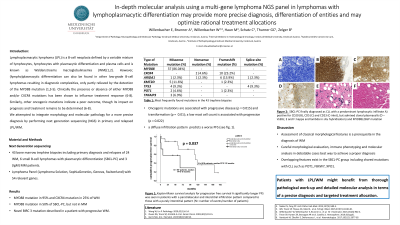Category: General Abstract
1011 - In-depth molecular analysis using a multi-gene lymphoma NGS panel in lymphomas with lymphoplasmacytic differentiation may provide more precise diagnosis, differentiation of entities and may optimize rational treatment allocations

Abstract
Aims: To enable a more precise diagnosis and to describe potentially prognostic and therapeutic relevant mutations a refined molecular analysis of formalin-fixed paraffin embedded and decalcified bone marrow trephine biopsies at time of primary diagnoses, as well as follow-up of 41 patients with lymphomas with lymphoplasmacytic differentiation (LPLs) was performed.
MATERIAL AND
Methods: Analysis was performed by means of a commercially available Lymphoma Panel (Lymphoma Solution, SophiaGenetics). Results were correlated with clinical and pathological parameters including pathological diagnosis, immune phenotype, volume of infiltration, infiltration pattern, and number of mast cells,
Results: Our group finally covered a spectrum of lymphomas with plasmacytic differentiation ranging from Waldenstroems macroglobulinaemia (WM), comprising the largest group, to small-B-cell lymphomas with plasmacytic differentiation (SBCL-PC) to IgM myeloma (MM). The most helpful diagnostic criteria were a combination of morphology including infiltration pattern and mast cell count, and immune phenotypes. The prototycical MYD88 L265P mutation was present in nearly all cases of WM but also in 50% of the SBCL-PC. Only MM were consistently negative for the mutation. We found that known oncogenic mutations, such as TP53 are already detectable early in the course of the disease and were associated with a significantly shorter PFS. In addition, we report on a novel BIRC3 frameshift mutation in a case of a progressive WM.
Conclusion: Our data indicate that patients with LPL might benefit from a thorough pathological work-up and a detailed molecular analysis in terms of a precise diagnosis and a more targeted treatment allocation.
Aims: To enable a more precise diagnosis and to describe potentially prognostic and therapeutic relevant mutations a refined molecular analysis of formalin-fixed paraffin embedded and decalcified bone marrow trephine biopsies at time of primary diagnoses, as well as follow-up of 41 patients with lymphomas with lymphoplasmacytic differentiation (LPLs) was performed.
MATERIAL AND
Methods: Analysis was performed by means of a commercially available Lymphoma Panel (Lymphoma Solution, SophiaGenetics). Results were correlated with clinical and pathological parameters including pathological diagnosis, immune phenotype, volume of infiltration, infiltration pattern, and number of mast cells,
Results: Our group finally covered a spectrum of lymphomas with plasmacytic differentiation ranging from Waldenstroems macroglobulinaemia (WM), comprising the largest group, to small-B-cell lymphomas with plasmacytic differentiation (SBCL-PC) to IgM myeloma (MM). The most helpful diagnostic criteria were a combination of morphology including infiltration pattern and mast cell count, and immune phenotypes. The prototycical MYD88 L265P mutation was present in nearly all cases of WM but also in 50% of the SBCL-PC. Only MM were consistently negative for the mutation. We found that known oncogenic mutations, such as TP53 are already detectable early in the course of the disease and were associated with a significantly shorter PFS. In addition, we report on a novel BIRC3 frameshift mutation in a case of a progressive WM.
Conclusion: Our data indicate that patients with LPL might benefit from a thorough pathological work-up and a detailed molecular analysis in terms of a precise diagnosis and a more targeted treatment allocation.
- EW
Ella E. Willenbacher, MD
senior physician
Medical University of Innsbruck
Innsbruck, Tirol, Austria - WW
- AB

